ETSI celebrates World Standards Day with ETSI Standards for a Better World
Sophia Antipolis, 14 October 2022
Today ETSI is joining the international standardization community in celebrating World Standards Day. This year’s edition focuses on a “shared vision for a better world”, where the UN Sustainable Development Goals (SDGs) are key enablers. Standards help to reach these goals.
At ETSI, we have decided to showcase six of our recently released ICT standards which help citizens to live in a better world, giving concrete examples of how people and the planet benefit from standards, and how they are aligned with the SDGs.
Cybersecurity for IoT Consumer Devices
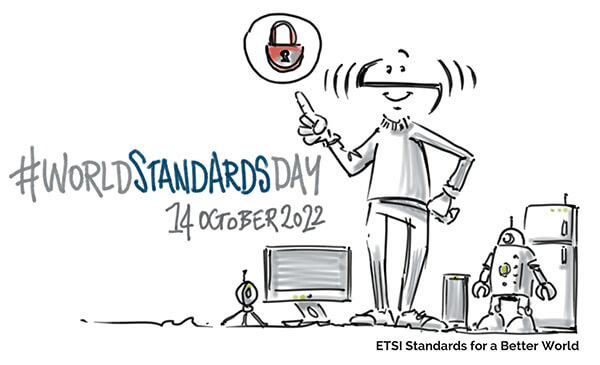 The first one is the ETSI global cybersecurity standard for IoT consumer devices (ETSI EN 303 645). This standard, already successfully implemented around the world, is designed to prevent large-scale, prevalent attacks against smart devices that cybersecurity experts see every day, by establishing a security baseline for connected consumer products, and provides a basis for future IoT certification schemes. Manufacturers can now secure your smoke detectors, door locks, smart cameras, TVs, wearable health trackers, alarm systems, smart fridges, children’s toys and baby monitors, and make sure they are not an open door for eavesdropping anymore.
The first one is the ETSI global cybersecurity standard for IoT consumer devices (ETSI EN 303 645). This standard, already successfully implemented around the world, is designed to prevent large-scale, prevalent attacks against smart devices that cybersecurity experts see every day, by establishing a security baseline for connected consumer products, and provides a basis for future IoT certification schemes. Manufacturers can now secure your smoke detectors, door locks, smart cameras, TVs, wearable health trackers, alarm systems, smart fridges, children’s toys and baby monitors, and make sure they are not an open door for eavesdropping anymore.
Sustainable ICT Infrastructures
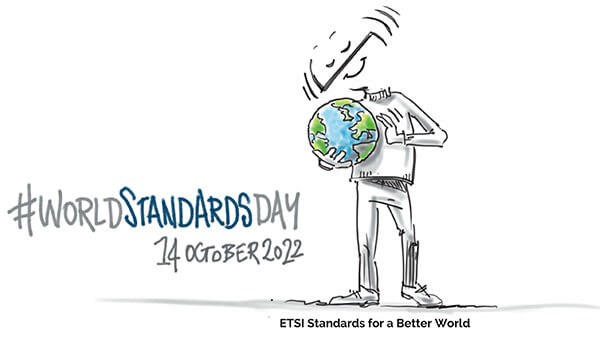 Greenhouse gas emissions continue to rise, while broadband penetration is introducing new active equipment into the network architecture. It is therefore vital that telecommunications operators implement effective general engineering of networks and sites to respond to the critical issue of greenhouse gas emissions, while proposing essential solutions for broadband deployment. Building a resilient infrastructure, as stated in SDG 9, is important for industry. At ETSI, we are helping the planet with a series of Key Performance Indicators (KPIs), ETSI ES 205 200-3-2, that monitor the global sustainability of ICT services and networks and their impact on greenhouse gas emissions. This standard enables greenhouse gas usage to be managed more effectively.
Greenhouse gas emissions continue to rise, while broadband penetration is introducing new active equipment into the network architecture. It is therefore vital that telecommunications operators implement effective general engineering of networks and sites to respond to the critical issue of greenhouse gas emissions, while proposing essential solutions for broadband deployment. Building a resilient infrastructure, as stated in SDG 9, is important for industry. At ETSI, we are helping the planet with a series of Key Performance Indicators (KPIs), ETSI ES 205 200-3-2, that monitor the global sustainability of ICT services and networks and their impact on greenhouse gas emissions. This standard enables greenhouse gas usage to be managed more effectively.
eHealth to Mitigate Global Pandemics
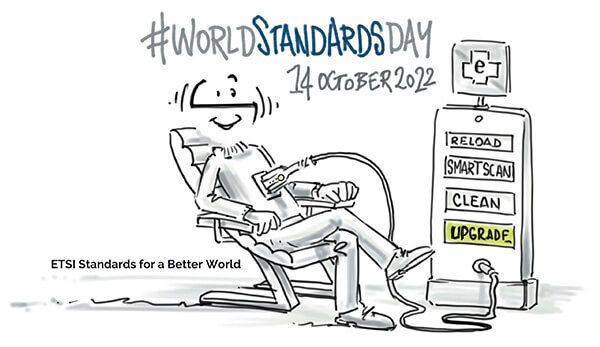 The nature of the COVID-19 pandemic revealed some weaknesses in social and organizational systems, that have resulted in adding significant stress to health care systems, and the various mitigation strategies employed have called into question the relative role of citizen's legal rights and entitlements. The ETSI eHealth committee has released a Special Report, ETSI SR 003 809, on the role of ICT to enable health crisis management and recovery. It supports societal responses to health crisis management and recovery and will help mitigate future global pandemics. This will ensure healthy lives and promote well-being for all, of all ages, as stated in SDG 3.
The nature of the COVID-19 pandemic revealed some weaknesses in social and organizational systems, that have resulted in adding significant stress to health care systems, and the various mitigation strategies employed have called into question the relative role of citizen's legal rights and entitlements. The ETSI eHealth committee has released a Special Report, ETSI SR 003 809, on the role of ICT to enable health crisis management and recovery. It supports societal responses to health crisis management and recovery and will help mitigate future global pandemics. This will ensure healthy lives and promote well-being for all, of all ages, as stated in SDG 3.
Precise Locations for Emergency Communications
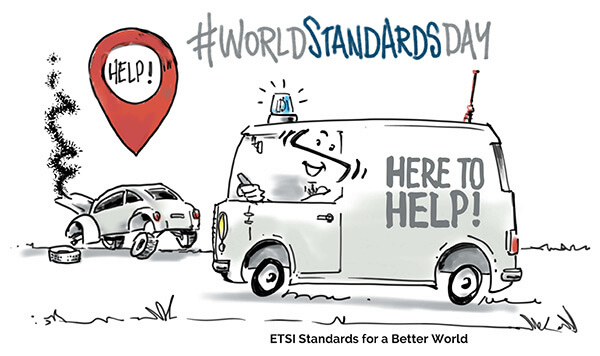 A person in an emergency situation is under a lot of stress and may not be able to communicate where the incident is occurring. One of the biggest challenges for the emergency services is determining the location of mobile callers. Ambulance service measurements show that, on average, 30 seconds per call can be saved, if a precise location is automatically provided. The ETSI Advanced Mobile Location (AML) standard, ETSI TS 103 625, enables precise mobile locations to be sent to emergency services. Advanced Mobile Locations is already deployed in 30 countries.
A person in an emergency situation is under a lot of stress and may not be able to communicate where the incident is occurring. One of the biggest challenges for the emergency services is determining the location of mobile callers. Ambulance service measurements show that, on average, 30 seconds per call can be saved, if a precise location is automatically provided. The ETSI Advanced Mobile Location (AML) standard, ETSI TS 103 625, enables precise mobile locations to be sent to emergency services. Advanced Mobile Locations is already deployed in 30 countries.
The 5G Standard, jointly developed by ETSI and six other standardization bodies
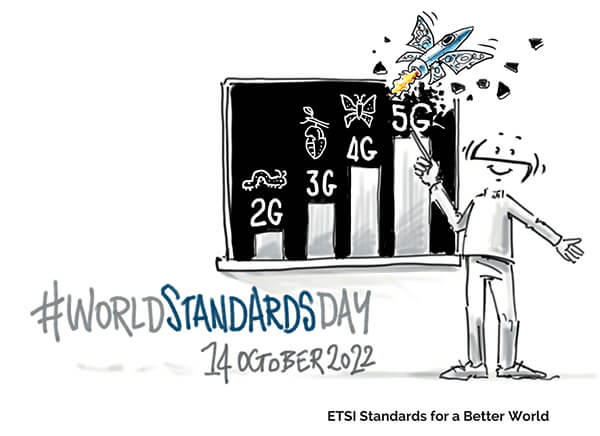 3GPP is the partnership project created after ETSI founded the GSM, or 2G, standard. After 3G and 4G, seven standardization organizations from around the world, including ETSI, have released the 5G standard, which is being deployed everywhere. Mobile telecommunications of today or tomorrow are defined and shaped by 3GPP. Without all these standards, smart phones and network infrastructures would not work all over the world as they do today. All 5G communications are being enabled today by the underlying 3GPP and ETSI standards. Think about it when using your smart phone!
3GPP is the partnership project created after ETSI founded the GSM, or 2G, standard. After 3G and 4G, seven standardization organizations from around the world, including ETSI, have released the 5G standard, which is being deployed everywhere. Mobile telecommunications of today or tomorrow are defined and shaped by 3GPP. Without all these standards, smart phones and network infrastructures would not work all over the world as they do today. All 5G communications are being enabled today by the underlying 3GPP and ETSI standards. Think about it when using your smart phone!
Safer Roads for Vulnerable Users
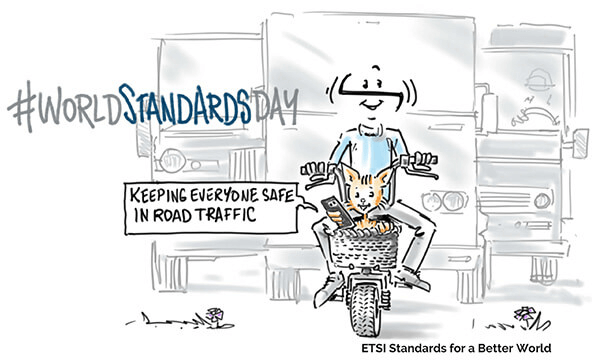 In today’s hectic traffic, it is important that road users and roadside infrastructures are informed about each other's positions, dynamics, and attributes. This awareness of one another is the basis of the ETSI standards for cooperative intelligent transport systems, road safety and traffic efficiency applications. It is achieved by the regular exchange of information between vehicles, pedestrians, and roadside infrastructures. To protect vulnerable road users, including pedestrians, cyclists, motorcyclists and animals, ETSI has released a standard, ETSI TS 103 300-3, for a safer city. This standard is aligned with SDG 11 to make cities and human settlements inclusive, safe, resilient, and sustainable.
In today’s hectic traffic, it is important that road users and roadside infrastructures are informed about each other's positions, dynamics, and attributes. This awareness of one another is the basis of the ETSI standards for cooperative intelligent transport systems, road safety and traffic efficiency applications. It is achieved by the regular exchange of information between vehicles, pedestrians, and roadside infrastructures. To protect vulnerable road users, including pedestrians, cyclists, motorcyclists and animals, ETSI has released a standard, ETSI TS 103 300-3, for a safer city. This standard is aligned with SDG 11 to make cities and human settlements inclusive, safe, resilient, and sustainable.
Join the World Standards Day celebrations online with the hashtag #WorldStandardsDay
About ETSI
ETSI provides members with an open and inclusive environment to support the development, ratification, and testing of globally applicable standards for ICT systems and services across all sectors of industry and society. We are a non-profit body, with more than 900 member organizations worldwide, drawn from over 60 countries and five continents. The members comprise a diversified pool of large and small private companies, research entities, academia, government, and public organizations. ETSI is officially recognized by the EU as a European Standardization Organization (ESO). For more information, please visit us at https://www.etsi.org/
Press contact
Claire Boyer
Tel.: +33 (0)6 87 60 84 40
Email: claire.boyer@etsi.org
